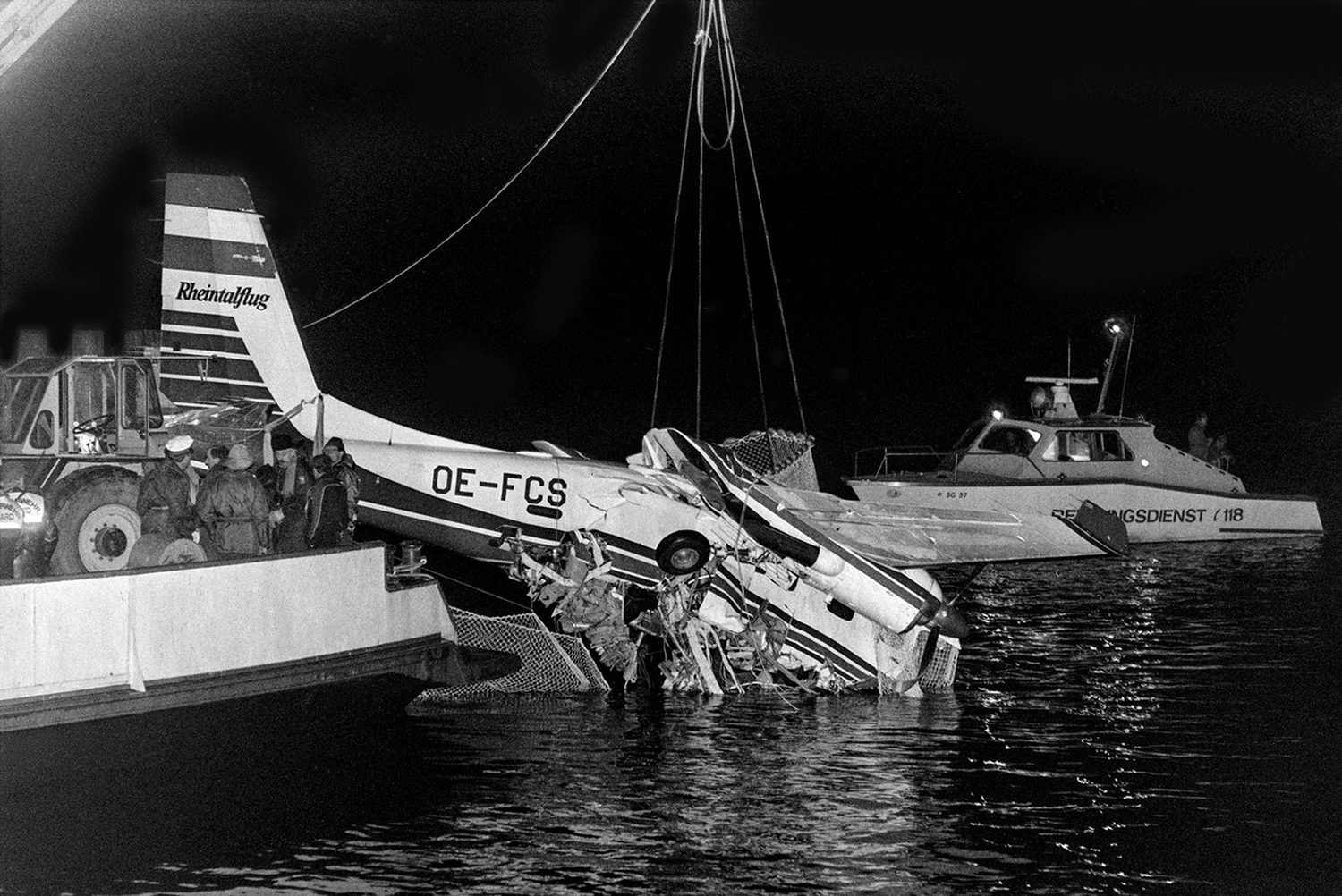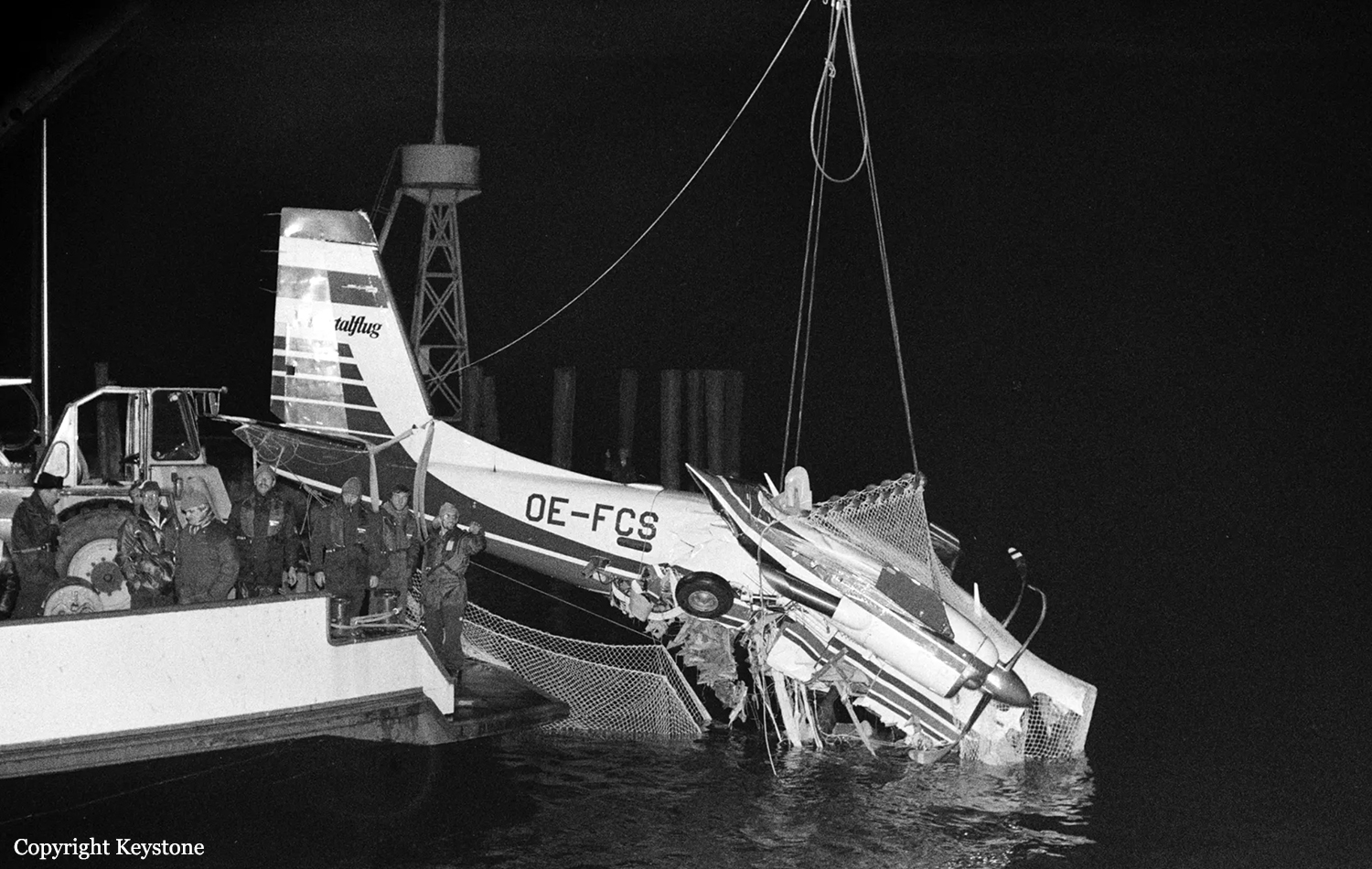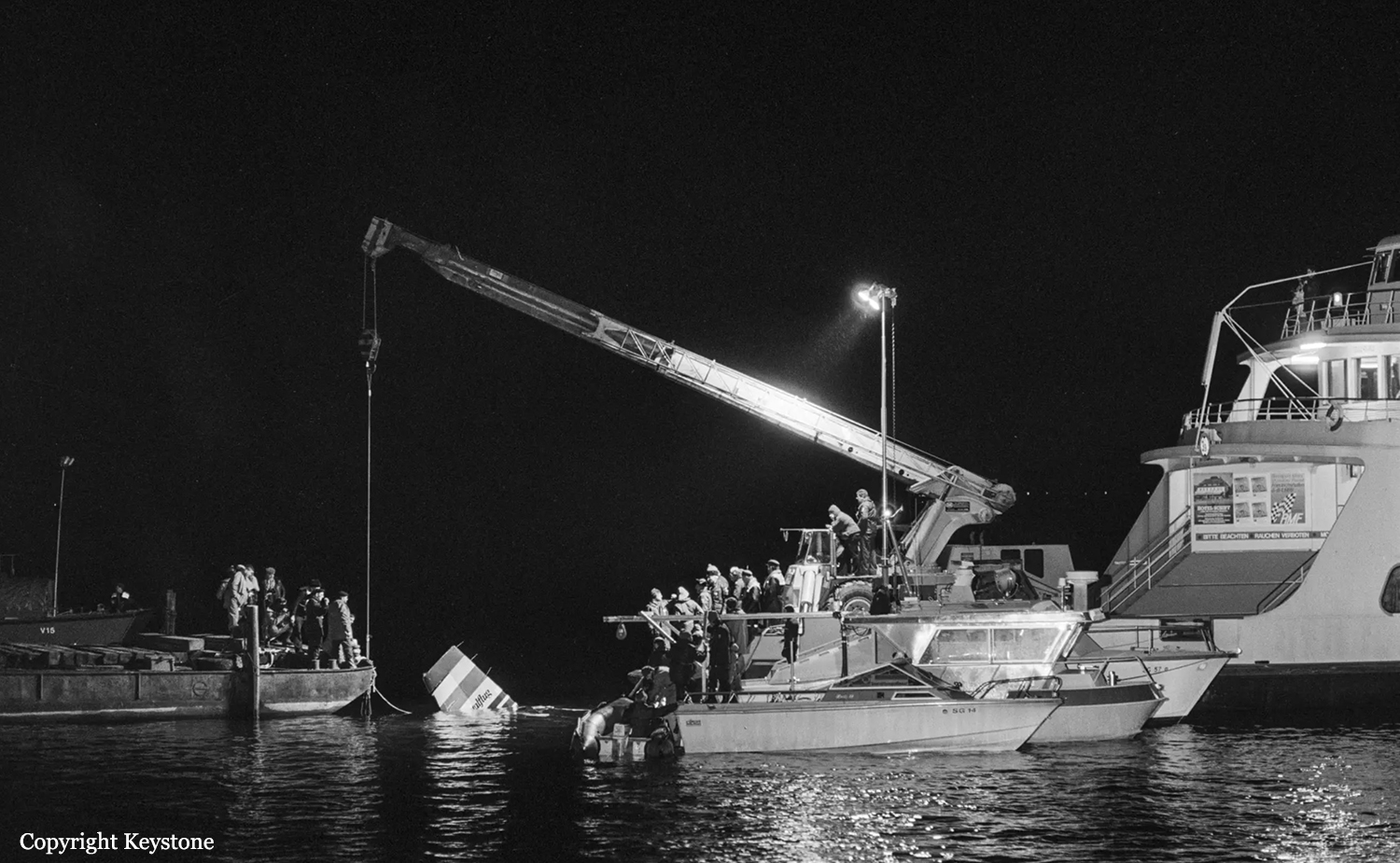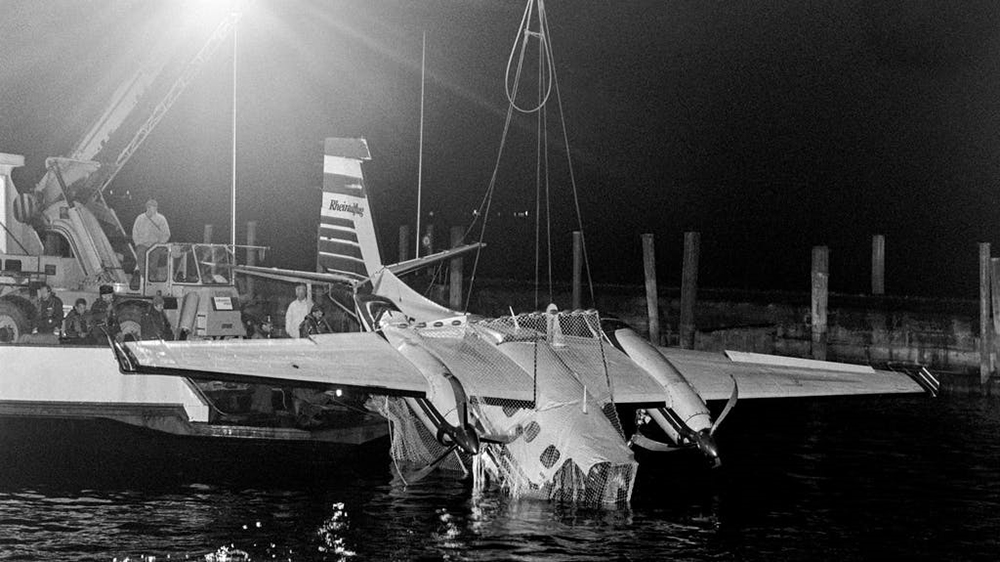Country
Crash of a Rockwell Gulfstream 690D Jetprop 900 in North Las Vegas: 1 killed
Date & Time:
May 5, 2005 at 0914 LT
Registration:
N337DR
Survivors:
Yes
Schedule:
North Las Vegas – San Diego
MSN:
690-15007
YOM:
1982
Crew on board:
1
Crew fatalities:
Pax on board:
2
Pax fatalities:
Other fatalities:
Total fatalities:
1
Aircraft flight hours:
5026
Circumstances:
The passenger flying the airplane made a hard landing after the pilot had experienced an incapacitating cardiac event. Shortly after takeoff the pilot turned the plane around to return to the departure airport. He started coughing and then went unconscious. The passenger in the right seat, who had no piloting experience, took control of the airplane and made several landing attempts. During the fourth landing attempt he stalled the airplane at a low altitude. The airplane impacted terrain, landing flat on its belly a few hundred feet short of the runway. The autopsy report attributed the pilot's cause of death to arteriosclerotic cardiovascular disease.
Probable cause:
The incapacitation of the pilot.
Final Report:

Crash of a Rockwell Gulfstream 690D Jetprop 900 off Altenrhein: 11 killed
Date & Time:
Feb 23, 1989 at 1059 LT
Registration:
OE-FCS
Survivors:
No
Schedule:
Vienna - Hohenems
MSN:
690-15036
YOM:
1984
Flight number:
RY102
Crew on board:
2
Crew fatalities:
Pax on board:
9
Pax fatalities:
Other fatalities:
Total fatalities:
11
Captain / Total hours on type:
1160.00
Copilot / Total hours on type:
400
Aircraft flight hours:
5197
Aircraft flight cycles:
4295
Circumstances:
The twin engine airplane departed Vienna-Schwechat Airport in the morning on a special flight to Hohenems-Dornbirn Airport, carrying nine passengers and two pilots, among them Alfred Dallinger, Austrian Minister of Labor. While descending to Hohenems Airport, the crew encountered poor weather conditions and decided to divert to Altenrhein Airport, Saint-Gall, Switzerland. At 1054, the aircraft passed the Altenrhein VOR at an altitude of 2,000 feet with an horizontal visibility estimated to 3-4 km with nebulosity. After completing the last turn to join the glide for a runway 10 approach, the aircraft was still over clouds at a 2,000 feet QNH altitude. Suddenly, the aircraft struck the water surface and crashed in the lake of Constance (Bodensee) about 5,100 metres short of runway 10 threshold. The wreckage was found off the village of Horn. The aircraft was destroyed by impact forces and all 11 occupants were killed.
Crew:
Brigitte Seewald, pilot +1.
Passengers:
Alfred Dallinger +8.
Crew:
Brigitte Seewald, pilot +1.
Passengers:
Alfred Dallinger +8.
Probable cause:
The accident was probably caused by the fact that the crew continued the approach under VFR mode in IMC conditions.
The following contributing factors were reported:
- Poor judgment of the weather situation prevailing in the approach sector,
- Deficiency in the distribution of tasks within the crew during the final approach,
- Improper use of the altitude alert / preselect system and the radio altimeter,
- The crew was stressed by the unfavorable weather conditions and the incoming of a layer of fog,
- Psychological pressure on the crew due to the presence on board of an important personality.
The following contributing factors were reported:
- Poor judgment of the weather situation prevailing in the approach sector,
- Deficiency in the distribution of tasks within the crew during the final approach,
- Improper use of the altitude alert / preselect system and the radio altimeter,
- The crew was stressed by the unfavorable weather conditions and the incoming of a layer of fog,
- Psychological pressure on the crew due to the presence on board of an important personality.
Final Report:





Crash of a Rockwell Gulfstream 690D Jetprop 900 in Price: 6 killed
Date & Time:
May 7, 1986 at 1106 LT
Registration:
N200PR
Survivors:
No
Schedule:
Colorado Springs - Price
MSN:
690-15029
YOM:
1983
Crew on board:
2
Crew fatalities:
Pax on board:
4
Pax fatalities:
Other fatalities:
Total fatalities:
6
Captain / Total hours on type:
421.00
Aircraft flight hours:
1560
Circumstances:
At 1042 mdt, the flight reported moderate turbulences at FL240, but elected to remain at that altitude. At 1055, they were cleared to descend at pilot's discretion to maintain 12,000 feet. Approximately 8 minutes later, shortly after beginning a descent, the flight was instructed to change frequency; but 21 seconds later, they replied 'standby please,' then radio and radar contact were lost. Wreckage was found approximately 26 miles east of the destination airport in mountains. An examination revealed the empennage had separated in flight; pieces of it were found up to one mile away with indication of overload failure. There was evidence that: engines were not operating at ground impact, ignition switches were engaged; left engine start switch was in the 'air' start position and right switch was beyond the 'ground' start position; right propeller was feathered; pax oxygen masks were deployed, indicating cabin had depressurized above 15,000 feet. Weather info indicated cloud bases at 10,000 feet with IMC and turbulences to 25,000 feet, mixed icing from 20,000 feet to 25,000 feet, light rain/snow showers, widely scattered thunderstorms; approximately 15 miles south, 4 inches to 5 inches of hail fellat approximately that time. TPE331 engines had history of flameouts due to ice ingestion caused by impossible use of anti-ice/ignition. All six occupants were killed.
Probable cause:
Occurrence #1: in flight encounter with weather
Phase of operation: descent - normal
Findings
1. (f) weather condition - clouds
2. (f) weather condition - low ceiling
3. (f) weather condition - turbulence in clouds
4. (f) weather condition - icing conditions
----------
Occurrence #2: loss of engine power (total) - nonmechanical
Phase of operation: descent - normal
Findings
5. (c) in-flight planning/decision - improper - pilot in command
6. (c) procedures/directives - not followed - pilot in command
7. (c) anti-ice/deice system - improper use of - pilot in command
8. (f) aircraft performance, two or more engines - inoperative
9. Fuselage, cabin - decompression
----------
Occurrence #3: loss of control - in flight
Phase of operation: descent - emergency
Findings
10. (c) aircraft handling - not maintained - pilot in command
11. (c) spatial disorientation - pilot in command
12. Remedial action - attempted
----------
Occurrence #4: airframe/component/system failure/malfunction
Phase of operation: descent - uncontrolled
Findings
13. (c) design stress limits of aircraft - exceeded
14. Horizontal stabilizer attachment - overload
15. Vertical stabilizer attachment - overload
16. Stabilizer - separation
----------
Occurrence #5: in flight collision with terrain/water
Phase of operation: descent - uncontrolled
Findings
17. Terrain condition - mountainous/hilly
Phase of operation: descent - normal
Findings
1. (f) weather condition - clouds
2. (f) weather condition - low ceiling
3. (f) weather condition - turbulence in clouds
4. (f) weather condition - icing conditions
----------
Occurrence #2: loss of engine power (total) - nonmechanical
Phase of operation: descent - normal
Findings
5. (c) in-flight planning/decision - improper - pilot in command
6. (c) procedures/directives - not followed - pilot in command
7. (c) anti-ice/deice system - improper use of - pilot in command
8. (f) aircraft performance, two or more engines - inoperative
9. Fuselage, cabin - decompression
----------
Occurrence #3: loss of control - in flight
Phase of operation: descent - emergency
Findings
10. (c) aircraft handling - not maintained - pilot in command
11. (c) spatial disorientation - pilot in command
12. Remedial action - attempted
----------
Occurrence #4: airframe/component/system failure/malfunction
Phase of operation: descent - uncontrolled
Findings
13. (c) design stress limits of aircraft - exceeded
14. Horizontal stabilizer attachment - overload
15. Vertical stabilizer attachment - overload
16. Stabilizer - separation
----------
Occurrence #5: in flight collision with terrain/water
Phase of operation: descent - uncontrolled
Findings
17. Terrain condition - mountainous/hilly
Final Report:

